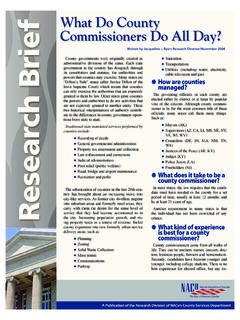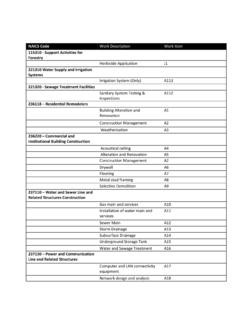Transcription of ImprovIng LIfeLInes: Protecting critical infrastructure ...
1 NOVEMBER 2014. National Association of COunties ImprovIng lifelines : Protecting critical infrastructure for resilient Counties ImprovIng lifelines : Protecting critical infrastructure for resilient Counties Contents Introduction .. 1. What are lifelines ? .. 2. Why lifelines Matter to Counties .. 3. The Four Major lifelines .. 4. Energy & Electricity.. 4. Water.. 7. Transportation.. 10. Telecommunications .. 13. Other Opportunities for County Actions .. 16. Conclusion.. 17. Additional Resources .. 18. Endnotes.. 18. Counties need to be able to prepare for, respond to and recover from disasters in a timely fashion, and as part of this preparation, they need to ensure that critical infrastructure , such as energy, water, communications and transportation, remain operational, or that service can be quickly returned to normal following a disaster.
2 Introduction There are a myriad of high-impact disruptions that counties across the country face each and every day. Ranging from natural disasters to structural failures to economic downturns, these events can impact natural environments and cause damage to homes or businesses. While the scope and size of disasters may vary, one commonality they all share is that they are expensive. On average, natural and man-made disasters cause an estimated $57 billion in damages and related costs each Large events can cost even more Hurricane Katrina, for example, cost upwards of an estimated $100 Damages to homes, businesses, roads, water infrastructure and energy plants, among others, can be extremely costly to counties, and the recovery efforts can last from days to even years.
3 Not only do extreme events like hurricanes, floods, tornados and fires threaten the financial health of counties all across the country, they threaten critical infrastructure known as lifelines , which are necessary for counties to function and provide vital services to the public. It is imperative for counties to understand the risks that weather- related events or economic downturns pose to their lifelines . Counties need to be able to prepare for, respond to and recover from disasters in a timely fashion, and as part of this preparation, they need to ensure that critical infrastructure , such as energy, water, communications and transportation, remain operational, or that service can be quickly returned to normal following a disaster.
4 This issue brief will serve as a guide for county leaders to help them understand the vulnerabilities of and threats to critical infrastructure in their county. By having a better understanding of the interconnectedness of lifelines , and how damages to one sector can cascade and affect others, county leaders will be better prepared to address vulnerabilities in their county and protect their lifelines . Case studies throughout will highlight the replicable work that large and small, urban and rural counties across the country are undertaking to ensure that their lifelines are ready for unforeseen events.
5 This issue brief includes case studies on the following counties: Electricity & Energy: Carroll County, Md. (page 6) Transportation: Hillsborough County, Fla. (page 11). Water: St. Clair County, Mich. (page 9) Telecommunications: Arlington County, Va. (page 15) ImprovIng lifelines : Protecting critical infrastructure for resilient Counties November 2014. 1. What are lifelines ? Counties provide the public with a number of programs and services; critical to these services are infrastructure systems that are vital for counties to operate. These lifelines , as they are known, are essential systems that serve residents and businesses throughout the county, often extending into the greater region.
6 Without these lifelines , counties would not be able to ensure the public's health and safety, as well as economic security. It is important to distinguish lifelines from what are known as life support systems, which include emergency services and public lifelines have a set of defining characteristics that separate them from other sectors and services provided. In general, there are four main factors that define lifelines : They provide necessary services and goods that support nearly every home, business and county agency, lifelines deliver services that are commonplace in everyday life, but disruption of the service has the potential to develop life-threatening situations, They involve complex physical and electronic networks that are interconnected within and across multiple sectors, and A disruption of one lifeline has the potential to effect or disrupt other lifelines in a cascading effect.
7 4. Each county has distinctive characteristics, be they geography and terrain, demographics or economic drivers. As such, the needs of a small rural county are going to be different than those of a larger urban county. Counties will invariably define lifelines differently from one another, but there are four main lifeline categories that apply to virtu- ally every county across the nation: Energy, such as oil, natural gas and electricity, Water, including potable water and wastewater systems, Transportation, including roads, bridges, rail, airports and ports, and Communications, including telephone, satellite and Internet infrastructure .
8 5. In addition to these four main categories, counties may consider other areas to be important lifelines , depending on the county's size, population and location. For example, San Francisco County classifies more than 12 different lifelines that it Flooding can damage county roads, hindering emergency response crews' ability to assist those in need, and disrupting normal business operations. ImprovIng lifelines : Protecting critical infrastructure for resilient Counties November 2014. 2. Why lifelines Matter to Counties Counties are tasked with Protecting the public's health, safety and welfare, and threats to lifelines could limit counties' ability to carry out this basic task.
9 There are a number of important aspects about lifelines that demand special attention. Interdependencies lifelines do not operate in a silo; rather, they are highly interconnected and dependent on one another, and it is this interconnectedness that necessitates counties to work to address the security and reliability of Counties are tasked its various lifelines . For example, a storm could knock a tree over and with Protecting onto power lines, which then causes a failure at a local substation, lead- ing to a widespread power outage. Not only would this disrupt power the public's health, to homes and offices, it could cut off power to a county's emergency communications Damages to a water main could impact the safety and welfare, public's supply of potable water, or interrupt HVAC operations at critical and threats to county buildings.
10 To complicate matters, much of the physical materials that make up life- lifelines could lines, including water pipes, electrical wiring, telecommunications fiber and natural gas pipes, are buried underground. This can make it hard limit counties'. for counties and other key players such as energy providers to know the ability to carry out exact location of an issue such as a burst pipe or cut cable, or to know the condition of the materials as they age. In addition, much of the ma- this basic task. terial is often buried in close proximity, which can put multiple systems at risk.







